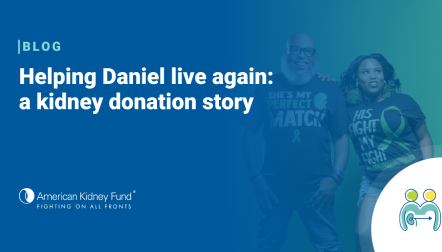
Blog post
How Dr. Samuel Lee Kountz, Jr. revolutionized kidney transplants

In honor of Black History Month, the American Kidney Fund (AKF) is celebrating a pioneer in the field of kidney transplant surgeries: Dr. Samuel Lee Kountz Jr.
Born in Lexa, Arkansas in 1930, Dr. Kountz had to work hard and overcome several obstacles to reach his goal of becoming a doctor. Despite failing the entrance exam at his first attempt applying for college, Dr. Kountz ultimately graduated third in his class at the University of Arkansas at Pine Bluff, followed by earning a Masters of Science in biochemistry from the University of Arkansas at Little Rock in 1952 and 1956, respectively. Although denied admission by the two black medical schools in the country, he still did not give up on his goal and was encouraged by Sen. William Fulbright to apply to the then all-white medical school at the university. Not only did Dr. Kountz gain entry — making him the first Black student to attend the University of Arkansas Medical School — but he received a scholarship to attend.
Dr. Kountz's perseverance through all these challenges would be enough reason to celebrate him. But he did not stop there. He continued his hard work, ultimately becoming an accomplished kidney transplant surgeon, performing over 500 transplants throughout his career (the most any one doctor had done at that point in time), and a brilliant researcher whose breakthroughs are still being used to make kidney transplants happen today.
Here are six ways Dr. Samuel Kountz revolutionized kidney transplants:
1. He performed the first successful kidney transplant between people who were not identical twins.
In 1961, Dr. Kountz was still a resident, training to be a surgeon at Stanford University, but he made history when he performed the first successful kidney transplant between non-identical twins. Prior to this time, transplants had only been done between twins because they share almost completely identical genes. With this successful surgery, Dr. Kountz opened up the possibilities of who could receive a transplanted kidney.
2. He discovered a drug regimen that helped stop the donor's body from rejecting a transplanted kidney.
In 1972, Dr. Kountz discovered that, along with monitoring blood flow post-transplant, injecting high doses of a steroid hormone called methylprednisolone helped to stop rejection of transplanted kidneys, allowing the body to accept the new organ. The drug regimens that kidney transplant recipients take today are a direct result of this discovery. Dr. Kountz's breakthrough helped make transplants between non-related people possible.
3. He helped develop the Belzer kidney perfusion machine to preserve kidneys when they are outside the body.
When an organ is removed from the body, it is cut off from the blood supply that keeps it functioning. If it is not connected back quickly enough, it cannot function anymore. This meant that finding a way to keep the organ functional while out of the body was critical for transplant surgery. In 1967, Dr. Kountz worked with Dr. Folkert O. Belzer at the University of California at San Francisco to develop a machine that did just that. Ultimately named after his partner, Dr. Kountz helped create the Belzer kidney perfusion machine, which preserves kidneys for up to 50 hours after they are removed from the body. It is still used in hospitals around the world.
4. He advanced tissue typing tests, widening the pool of transplant donors for kidney patients and improving transplant results.
An important part of getting a kidney transplant is finding someone who is "a match" for you. This means finding someone who has a blood type and tissue type that is similar enough to yours that the body won't reject the organ. Dr. Kountz helped advance tissue typing tests that help identify whether the possible donor is a good match for the recipient. Finding these matches helps significantly reduce the chance the recipient's body will reject the new organ.
5. He advocated for earlier reimplantation after a kidney transplant.
Dr. Kountz pushed to make earlier reimplantation the standard procedure after a failed kidney transplant. With reimplantation, a second kidney is transplanted at the earliest signs that the first is being rejected. According to a 1969 University of California at San Francisco newsletter, Dr. Kountz even developed a "special radio-isotope technique to detect rejection many days, even weeks, before any noticeable changes in kidney function."
6. He performed a live kidney transplant on TV to encourage others to become donors.
Through the advancements he helped make, kidney transplants could now take place between strangers. Despite this, the demand far outweighed the supply (and still does today). So, Dr. Kountz actively encouraged people to become kidney donors. As part of this effort, in 1976, he performed a live kidney transplant on NBC's Today show. After the airing, 20,000 people offered to donate a kidney.
Dr. Kountz's accomplishments expand beyond this list. He held numerous leadership positions throughout his career, published 76 professional papers, earned three honorary degrees and won numerous awards, including the Young Investigator's Award from the American Cardiology Association in 1964. In 1972, he was recruited to be the chief of general surgery at Kings County Hospital and the chairman of the department of surgery at State University of New York Downstate Medical Center in Brooklyn, which he accepted because he wanted to improve the health care conditions for the Black community in that area.
Tragically, Dr. Kountz caught an unknown neurological disease in 1977 while he was a visiting professor at a university in South Africa. The disease caused mental and physical damage that he never recovered from and Dr. Kountz died in 1981 at the age of 51.
Despite his short life, Dr. Kountz's impact on the way kidney transplants are performed today is huge. So, if you are living with a kidney transplant, don't forget to thank your donor and Dr. Samuel Kountz.
Resources
- DR. SAMUEL KOUNTZ, 51, DIES; LEADER IN TRANSPLANT SURGERY - The New York Times (nytimes.com)
- 7 Black surgeons who've shaped medicine throughout history | Department of Surgery (arizona.edu)
- Topic | Dr. Samuel Lee Kountz | The History of African Americans in the Medical Professions (virginia.edu)
- Kountz, Samuel Lee, Jr. - Encyclopedia of Arkansas
- Samuel Kountz, Pioneering Kidney Transplant Surgeon | Brought to Light (ucsf.edu)
- Kountz, Jr., MD | Arkansas Black Hall of Fame (arblackhalloffame.org)
Image details
Title: Samuel Kountz in surgical cap
Date: circa 1972
Collection: UCSF History Collection
Owning Institution: UC San Francisco, Library, University Archives
Source: Calisphere
Permalink: https://calisphere.org/item/84c99bd3-7380-4bd2-888f-c8fab9c07aaf/





